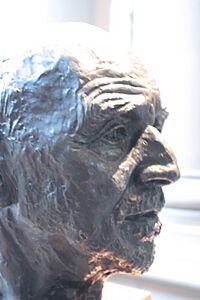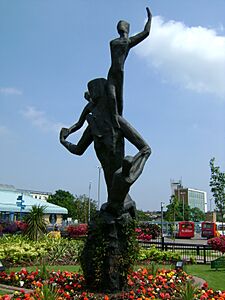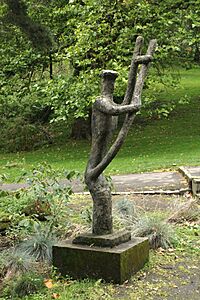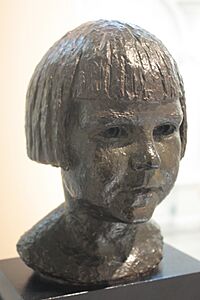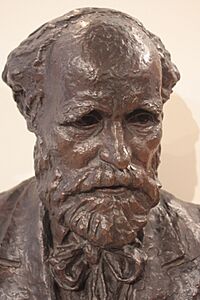Benno Schotz facts for kids
Quick facts for kids
Benno Schotz
|
|
|---|---|

Benno Schotz in 1949, taken by Lida Moser
|
|
| Born | 28 August 1891 Arensburg, Livonia, Russian Empire
|
| Died | 11 October 1984 (aged 93) |
| Resting place | Jerusalem |
| Education | Royal Technical College, Glasgow School of Art |
| Known for | Sculptor |
Benno Schotz (born August 28, 1891 – died October 11, 1984) was a famous sculptor. He was born in Estonia but became one of Scotland's most important artists in the 1900s.
Contents
Benno Schotz: A Life in Sculpture
Early Life and Education
Benno Schotz was the youngest of six children. His parents were Jacob Schotz, a watchmaker, and Cherna Tischa Abramovitch. He went to school in Pärnu, Estonia. Later, he studied in Darmstadt, Germany.
In 1912, he moved to Glasgow, Scotland. He earned a diploma in engineering there. From 1914 to 1923, he worked at a shipbuilding company. During this time, he also took evening classes in sculpture at the Glasgow School of Art.
Becoming a Full-Time Artist
Schotz became a full-time sculptor in 1923. An important early supporter was William Boyd, an art collector from Dundee. Because of Boyd's help, some of Schotz's works are now in the Dundee Dental School and Dundee Art Galleries & Museums.
His fame grew steadily. He became a full member of the Royal Scottish Academy. From 1938 until his retirement in 1961, he led the sculpture department at the Glasgow School of Art.
In 1963, he received a special honor. He was named the Sculptor in Ordinary for Scotland. This means he was the official sculptor to the Royal household in Scotland. Some of his students included famous artists like Hannah Frank and Inge King.
His Home and Beliefs
Schotz's homes in Glasgow were popular places. Artists, writers, actors, and politicians often met there. He was also a member of the Glasgow Art Club. He helped refugees, including artists like Jankel Adler.
He was a strong supporter of Zionism, which is the movement for the development and protection of a Jewish nation in what is now Israel. He was also very proud of Scotland, his adopted country. He continued to work on his art until just weeks before he died at age 93. He was buried in Jerusalem.
In 1981, he was given the "Freedom of the City of Glasgow." This is a special award given to people who have done great things for the city. That same year, his autobiography, Bronze in My Blood, was published.
Famous Sculptures and Artworks
During his long career, Benno Schotz created hundreds of artworks. These included portraits of people, religious sculptures, and abstract pieces. He also made many figure compositions.
Many of his works can be seen in public places, especially in Glasgow and the surrounding areas. Here are some examples:
- A sculpture of James Maxton is on display in the Maxton remembrance garden near Paisley.
- The Memorial to Provost John Jarvie of Kilsyth (1954) is a portrait in relief. You can see it in John Jarvie Square, Kilsyth.
- The Psalmist (1974) is in the T. J. Honeyman Memorial Garden in Kelvingrove Park.
- The Joseph Black Memorial (1953) is at the University of Glasgow.
- Statues of Saints Margaret and Ninian are on the front of the former Bank of Scotland building on Sauchiehall St.
- The Painting and Sculpture reliefs are on the Mercat Building (1928–29).
- The Stations of the Cross sculptures are in St. Charles' Parish Church in North Kelvinside.
- A Crucifix is in St Columba's Church, Woodside, Glasgow.
- Ex Terra is in Glenrothes town centre.
- A bust of James Pittendrigh Macgillivray is in the Scottish National Portrait Gallery (1924).
- Busts of William Boyd, Mrs William Rettie, and William Tattersall are in Dundee Dental Hospital & School.
- A bust of William Boyd's daughter Joan is at The McManus: Dundee's Art Gallery & Museum.
- A bust of Keir Hardie is in the People's Palace, Glasgow.
- An eleven-foot-high sculpture called 'The Window on the World' is at Vale of Leven Academy in Alexandria.
Schotz also helped repair a bridge sculpture in Kelvingrove Park. Even though he was born in Estonia, he spent his entire professional life in Scotland. He became a British citizen in 1930.
He continued to create art with great energy even after retiring from the Glasgow School of Art in 1960. His most ambitious works were made in the last 20 years of his life. In 1971, a big exhibition of his works was held in Edinburgh.
He also became very interested in drawing trees. His drawings became more complex and abstract over time. He had a successful exhibition of his sculptures and drawings in Glasgow in 1961. His very last sculpture was finished less than six weeks before he passed away.
Benno Schotz received many honors throughout his life. These include the Freedom of the City of Glasgow and honorary degrees from universities. He was also an honorary member of several important art and architecture societies.
Gallery
-
The Psalmist (1974). Kelvingrove Park, Glasgow, Scotland
-
Keir Hardie, Peoples Palace, Glasgow


